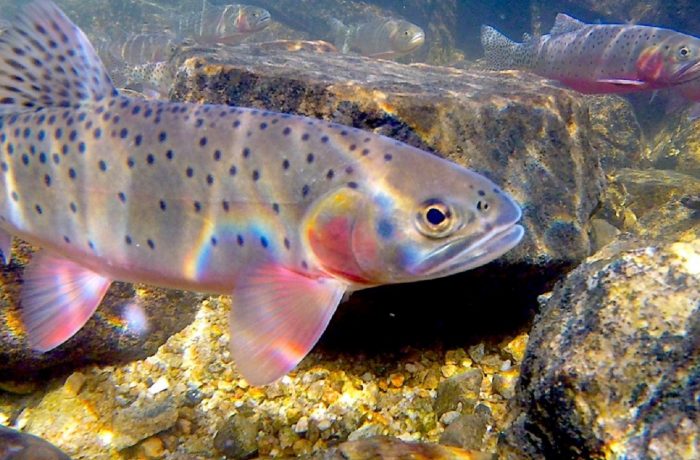Pisces played an important role in the discovery and reestablishment of Greenback Cutthroat trout in Colorado. The story of the Greenback is complicated and goes back over a hundred years.
Greenback Cutthroat trout, the Colorado state fish, were historically found in streams and lakes of Colorado’s South Platte and Arkansas River drainages on the east side of the Continental Divide. Over the last century the species’ range declined from over 13,000 km of lakes, rivers and streams to about 70 km, caused by mining pollution, fishing pressure, and displacement by the stocking of non-native Rainbow, Brook and Brown trout. By the early 1900s, Greenbacks were only found in a select few tributaries of the upper Arkansas River, and in 1937 the subspecies was declared extinct. Then in the 1950s, a presumed pure population of Greenbacks were found in a headwater stream of the South Platte River. Following this discovery, new surveys found additional populations of Greenbacks in high elevation streams above the South Platte and Arkansas River drainages. Due to these discoveries, the greenback was federally listed as an endangered species and active management by USFWS and Colorado Parks & Wildlife (CPW) began.
In his 2002 book, Trout and Salmon of North America, Bob Behnke at Colorado State University, described two distinct lineages of Cutthroats on either side of the Continental Divide - Greenback Cutthroats east of the Divide and Colorado River Cutthroat west of the Divide. Behnke’s work and a growing desire to “bring back the natives” prompted additional research on Cutthroat populations and lineages in Colorado. Pisces became involved in this research in a project with CPW to develop genetic tests to distinguish Colorado River, Greenback, Yellowstone and Rio Grande Cutthroats and Rainbow trout, and to determine the purity or level of hybridization between these subspecies or species. The procedure we developed used DNA extracted from non-lethal fin clip samples together with a set of 119 Amplified Fragment Length Polymorphism (AFLP) markers and STRUCTURE, a Bayesian probability population assignment program, to assign unknown fish to a particular subspecies and/or whether they were pure or hybridized with another Cutthroat subspecies or Rainbow trout. CPW has used this AFLP analysis to assess taxonomic status and purity of Cutthroat populations since 2007; to date Pisces has tested more than 18,000 samples.
In collaboration with CPW and Pisces, Drs. Jessica Metcalf and Andrew Martin at the University of Colorado found that several Front Range Cutthroat populations thought to be Greenbacks were actually genetically most closely related to Cutthroat populations west of the Divide rather than to populations east of the Divide as predicted by Behnke’s model. Additionally, she found west slope populations that were genetically most closely related to Greenbacks. Additional populations west of the Divide collected by Kevin Rodgers at CPW and analyzed with AFLPs found that this mix-up of Colorado River Cutthroat and Greenback Cutthroat genotypes on both sides of the Divide was much more widespread than originally assumed, and “could reflect a more complex phylogenetic past that has been masked by recent hatchery activity.” (https://cpw.state.co.us/Documents/Research/Aquatic/CutthroatTrout/SevenLakesPPN.pdf). And that at least two of the strains being grown in CPW hatcheries as Greenbacks actually had Colorado River Cutthroat genotypes, much to the consternation of the hatchery managers. (https://www.sciencedaily.com/releases/2007/09/070905133602.htm)
In conjunction with this unraveling of east slope versus west slope genotypes, Pisces participated in a new research project to analyze DNA extracted from museum trout specimens collected from sites around Colorado and New Mexico as far back as 1857 - before fish stocking was common - and compare this data to modern day samples to help understand the current distribution of Cutthroat subspecies across Colorado. As part of this work, an oddball population whose genotype didn’t fit with either the Colorado River Cutthroat or Greenback Cutthroat genotypes was discovered in Bear Creek, a small tributary of the Arkansas River (and dubbed “weird Bear Creek”). Phylogenetic comparison of Bear Creek and the historical trout samples led to the conclusion that this population was the only extant pure population of Greenback Cutthroat trout, Oncorhynchus clarkii stomias (Metcalf, et al, 2007, doi: 10.1111/j.1365-294X.2007.03472.x).
In 2012 CPW brought adults from the Bear Creek population into the Mt. Shavano Fish Hatchery. It took some years to establish a broodstock because the Bear Creek population was small and relatively inbred. However, ongoing rearing and stocking efforts of these fish resulted in the discovery in the fall of 2022 of Greenback fry in Herman Gulch, one of the first places stocked with the Bear Creek strain, making it the first naturally reproducing Greenback population in the state. Pisces was privileged to have had a role in the reestablishment of Greenback Cutthroat trout, once thought to be extinct in Colorado.

